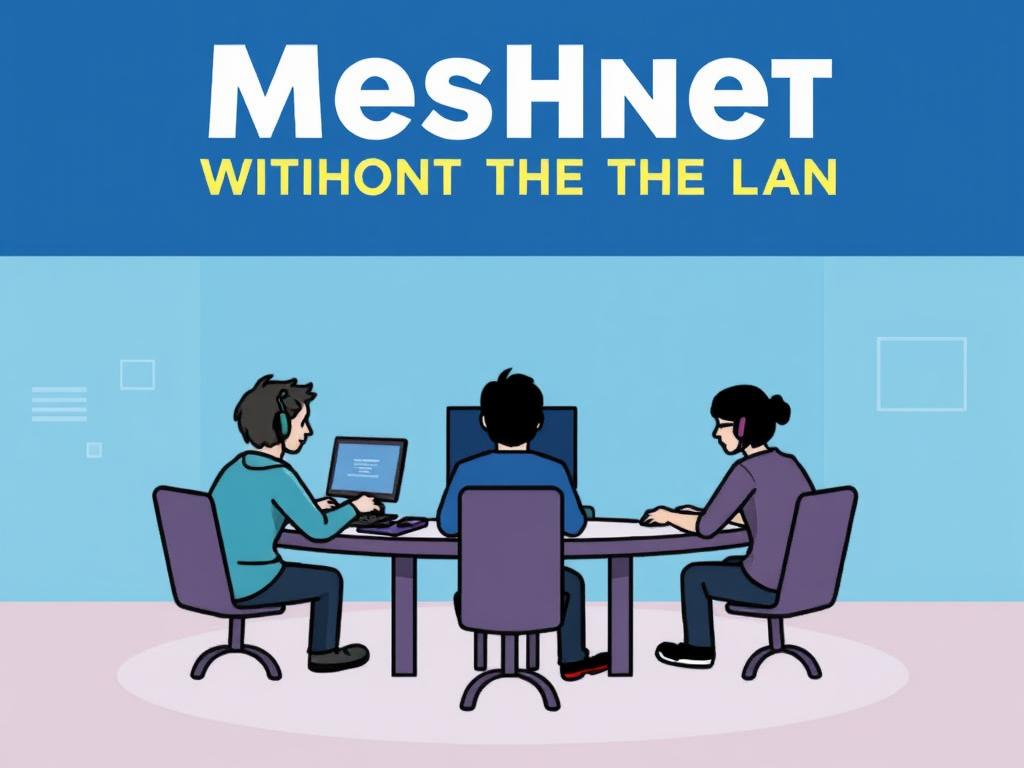What Is Meshnet Gaming and Why Should You Care?

Imagine playing your favorite multiplayer games with friends, feeling the excitement of a local area network (LAN) party, but without the hassle of gathering in the same physical space or worrying about complicated network setups. That’s precisely what meshnet gaming promises—a new way to experience LAN parties without the LAN. Meshnet gaming leverages advanced networking technologies to connect players directly over the internet, creating a virtual LAN environment. This means gamers can enjoy the low latency, smooth performance, and camaraderie traditionally associated with LAN parties, but from the comfort of their own homes or anywhere in the world.
The concept of meshnet gaming is fascinating because it taps into the best of both worlds: the social, real-time gaming experiences that LAN parties provide, combined with the flexibility and convenience of online play. Unlike standard online gaming, which often relies on centralized servers, meshnet gaming connects players in a decentralized peer-to-peer network. This setup reduces latency spikes, improves connection reliability, and can even increase security by avoiding public servers that might be prone to attacks or downtime.
How Meshnet Technology Works Behind the Scenes
At the heart of meshnet gaming is the mesh network—a type of network infrastructure where each participant’s device (or “node”) connects directly to other nodes, forming a web-like structure. This contrasts with traditional networks that rely heavily on central hubs or routers. In meshnet gaming, every player essentially acts as a mini-server, routing data directly among the group. This peer-to-peer model allows for incredibly efficient data exchange, which translates into a gaming experience that feels just like a LAN party, even if players are continents apart.
One of the benefits of this model is its scalability and resilience. Because the network routes data dynamically, if a connection between two nodes slows down or drops, the system reroutes the data through other devices automatically. This makes meshnet gaming more robust against connectivity issues than conventional setups.
Here’s a simple breakdown of how meshnet gaming works:
- Each player installs special meshnet software to create their node on the network.
- The software establishes secure, direct connections with other players’ nodes.
- Data packets (like game signals) travel through these direct connections, minimizing latency.
- The network adjusts dynamically to maintain optimal routes for data transmission.
The Advantages of Meshnet Gaming Over Traditional Online Multiplayer

Meshnet gaming solves several pain points that traditional online multiplayer games often face. For example, players regularly complain about lags, server downtime, and unpredictable latency due to congested or distant game servers. Meshnet gaming offers a solution by eliminating the middleman—the game server—allowing players to connect directly, much like a localized gaming session.
Here’s a table outlining the key differences between traditional online gaming and meshnet gaming:
| Feature | Traditional Online Gaming | Meshnet Gaming |
|---|---|---|
| Network Topology | Centralized servers | Decentralized peer-to-peer mesh |
| Latency | Variable and often higher, depends on server location | Lower and more consistent, direct node connections |
| Reliability | Depends on server uptime | Resilient due to dynamic routing |
| Security | Vulnerable to DDoS attacks on servers | More secure, encrypted peer connections |
| Setup Complexity | Usually easy, but depends on game | Requires meshnet software installation |
Setting Up Your Own Meshnet Gaming Session

If you’re excited to try out meshnet gaming, getting started is easier than you think. Many software solutions offer intuitive meshnet capabilities tailored explicitly for gamers. To set up a meshnet gaming session, follow these general steps:
- Choose a meshnet gaming software platform (some popular options include ZeroTier, Tailscale, and Hamachi).
- Install the software on all participants’ computers or devices.
- Create a secure, private virtual network and invite friends to join.
- Once everyone is connected, launch the multiplayer game of choice and select the LAN multiplayer mode.
- Enjoy your lag-free, meshnet-powered LAN party experience!
It’s important to ensure all players have decent internet connections because the quality of the meshnet experience depends on each node’s network performance. However, the dynamic routing nature of meshnets often compensates for weaker links in the network, providing an overall smoother experience than traditional online play.
What Games Work Best with Meshnet Gaming?
Many multiplayer games that support LAN play naturally align well with meshnet gaming since the meshnet creates a virtual LAN. Here are some typical genres and examples that meshnet enthusiasts enjoy:
- First-Person Shooters (FPS): Games like Counter-Strike: Global Offensive, Call of Duty (LAN modes), and Quake offer thrilling real-time action.
- Real-Time Strategy (RTS): Titles such as StarCraft II and Age of Empires II deliver fast-paced tactical gameplay ideal for low-latency LAN-style matches.
- Sandbox and Survival: Minecraft and Terraria are incredibly popular for cooperative and competitive play over meshnets.
- Racing Games: For example, the Need for Speed series and Trackmania benefit from seamless multiplayer with minimal lag.
Essentially, any game that supports LAN multiplayer can often be adapted for meshnet gaming, unlocking a powerful way to rekindle the fun and intimacy of old-school LAN parties.
Challenges and Considerations for Meshnet Gaming
While meshnet gaming sounds perfect, it’s essential to be aware of some practical challenges. First, the setup process might intimidate players used only to traditional online gaming. Installing and configuring meshnet software requires some technical know-how, although modern solutions have simplified this significantly.
Additionally, some games employ aggressive anti-cheat systems or DRM protections that may interfere with meshnet functionality. Always verify that the game you want to play doesn’t block peer-to-peer networking or require direct server connections.
From a privacy perspective, meshnet gaming is generally secure because connections are encrypted, but trust between participants is vital, especially if playing with unfamiliar players. Since each node routes data, malicious actors could attempt man-in-the-middle attacks in poorly configured meshnets.
Lastly, while meshnets reduce latency for most players, the quality of the experience is still largely dependent on each individual’s internet speed and reliability. Players with slow or unstable connections might inadvertently affect others in the network.
The Future of Meshnet Gaming: Beyond LAN Parties
Meshnet gaming hints at a broader shift in how games will be played and experienced online. As networking technology grows smarter and decentralized architectures gain popularity, we might see more widespread adoption of meshnet-style gaming. This would empower players to create private, secure, and highly responsive gaming environments tailored specifically to their needs.
Moreover, meshnets could potentially integrate with cloud gaming services, enabling hybrid models that combine the low-latency benefits of local connections with the computational power of the cloud. This could ultimately make online multiplayer gaming more accessible and enjoyable for everyone.
Beyond entertainment, meshnet principles could revolutionize virtual social spaces, esports hosting, and remote cooperative work in creative applications. The idea that networks can organically and distributedly form strong connections is powerful and opens countless possibilities.
Tips to Maximize Your Meshnet Gaming Experience
To get the best out of your meshnet gaming sessions, consider these handy tips:
- Use wired Ethernet connections wherever possible to reduce latency and improve stability.
- Choose a meshnet solution with strong encryption and privacy features to keep your games and data safe.
- Coordinate with friends to schedule gaming times to ensure everyone can join simultaneously without network overloads.
- Regularly update your meshnet software and game clients to fix bugs and enhance compatibility.
- Experiment with different routing and connection settings in the meshnet software to optimize performance based on your geographic locations.
Conclusion
Meshnet gaming is revolutionizing the way we experience multiplayer games, offering an exciting alternative to traditional online play by recreating the thrill and intimacy of LAN parties without the need to be in the same room. This technology leverages decentralized networks to reduce latency, boost reliability, and enhance security, providing an experience remarkably close to classic local gaming but with the freedom of global connectivity. While challenges like setup complexity and connection quality remain, the potential benefits make meshnet gaming a compelling choice for any multiplayer enthusiast seeking smoother, more immersive gameplay with friends near or far. As meshnet technologies advance and gain traction, the future of gaming looks increasingly interconnected, private, and player-driven—a true gaming renaissance without borders.
